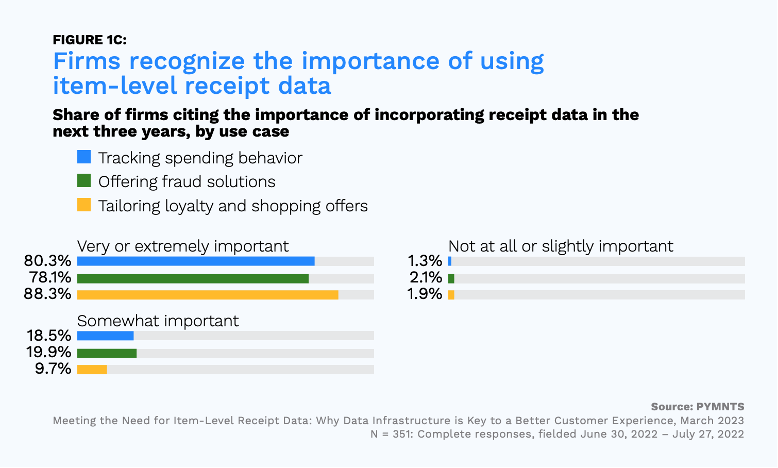A sticky customer base makes for a happy business.
And the technical opportunities and innovations embedded across today’s data-rich operating landscape are helping financial institutions, FinTechs and merchants unlock more than has ever been possible before from the payment occasion — particularly around item-level receipt data.
This, as research in the 2023 report “Meeting the Need for Item-Level Receipt Data: Next Steps in Receipt Data Adoption,” a PYMNTS collaboration with Banyan, finds that nearly 9 out of 10 firms (88%) believe the most important impact data can have is on personalization — specifically tailored offers and rewards.

But that’s not all. While most firms agree that the line items on a receipt are the key to more personalized rewards and stickier customer relationships, 8 in 10 (80%) emphasize that using item-level receipt data to track spending behavior is an opportunity area, while nearly 8 in 10 (78%) note that item-level receipt data also offers increasingly valuable fraud solutions.
PYMNTS research finds that among those firms highly interested in using receipt data to tailor loyalty and shopping offers, 9 in 10 (90%) consider technical infrastructure very or extremely influential.
After all, in order to capture and keep customers, organizations need to ensure they have the appropriate level of data-readiness from a back-end perspective to be able to fully execute on their growth and loyalty building initiatives.
Advertisement: Scroll to Continue
The data show that financial institutions and FinTechs able to deliver personalized digital experiences can increase customer engagement, while merchants who capture item-level receipt data and have the ability to activate that information can streamline the purchasing experience and create new sources of sales revenue.
In other words, banks that take advantage of data-decisioning are better able to drive increased digital engagement and top-of-wallet spend behavior, while merchants are able to widen and deepen their sales funnel and loyalty moats by delivering relevant, personalized rewards programs and card-linked offers at a category or product level.
If those benefits don’t keep customers coming back, then it might be worth taking a look in the mirror.
To learn more about how incorporating receipt data into business operations can provide the experiences digitally savvy consumers’ demand, download the free PYMNTS report, “Meeting the Need for Item-Level Receipt Data: Next Steps in Receipt Data Adoption.”

